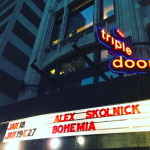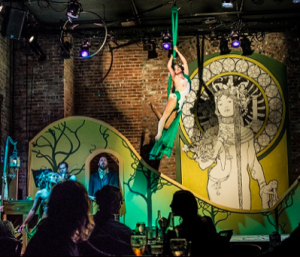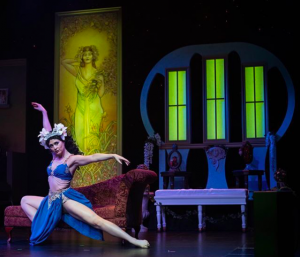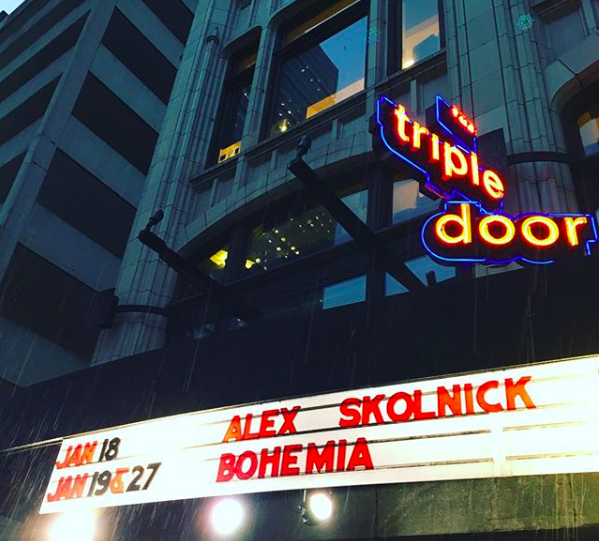
Photo Courtesy of Mark Siano on Instagram
The Triple Door transformed itself into a cabaret theater on Saturday night for the second of many performances of Bohemia. Bohemia is a play about music, art, love, and absinthe; it incorporates laugh out loud humor with jaw dropping singing and awe inducing dancing (a pretty good Saturday night if you ask me).

For a little background: Bohemia is a region encompassing the western Czech Republic and is centered on the national capital of Prague. This use of the word bohemian first appeared in the English language in the nineteenth century to describe the non-traditional lifestyles of marginalized and impoverished artists, writers, journalists, musicians, and actors in major European cities. Bohemian people were associated with unorthodox or anti-establishment political or social viewpoints, which often were expressed through free love, frugality, and—in some cases—voluntary poverty.
A little more background: Absinthe is a drink that has been described as “the cocaine of the nineteenth century”. With an alcohol by volume sometimes as high as 80 percent, absinthe was made by mixing the leaves of wormwood with other plants such as angelica root, fennel, coriander, hyssop, marjoram and anise for flavor. The result was a bitter, potent drink that became a major social, medical and political phenomenon during the late nineteenth and early twentieth centuries; its popularity was mainly in France, but also in other parts of Europe and the United States. Absinthe produced a sense of euphoria and a heightening of the senses, similar to the effect of cocaine and opium, but was addictive and caused a rapid loss of mental and physical faculties. Despite that, Picasso, Manet, Rimbaud, Van Gogh, Degas and Wilde were among those devoted to its consumption and produced writings and art influenced by the drink. While under the influence of absinthe, people were said to be visited by “the green fairy”. Absinthe is now illegal in the United States, but still available abroad.
Now for the show: Bohemia is a musical performance about a man named Antonin Dvorak, a musical composer in the nineteenth century, who hit a dry spell while trying to compose his ninth symphony. Recent reviews of his work were not flattering, and he was feeling deflated when one night, an artist named Mucha came to visit him, and brought him some absinthe. Dvorak quickly downed the absinthe, not knowing of its dangerous hallucinogenic qualities and promptly passed out on his piano.

It is then that we, the audience, met Wormwood the green fairy. Wormwood was the narrator of the musical and “had no regards for the fourth wall” she said before stepping down into the audience and taking a sip of a spectator’s drink. She had a hearty laugh and was a funny character, both qualities one would want in a narrator, in my opinion.
Wormwood was accompanied by five other green fairies in sparkling, elegant costumes, all of whom were part of Dvorak’s hallucinations. They danced and sang and giggled and joked with Dvorak while he tried to comprehend what was going on. His hallucination was his desperate attempt to find inspiration for his ninth symphony, which he wanted to be his best one yet.
He was then greeted by Frederic Chopin, a musical composer as well, but one who only became famous after his death. Chopin was Dvorak’s role model and visited him and the green fairies in attempt to help Dvorak find his muse.

Chopin was played by Opal Peachey, one of the writers and composers of Bohemia. She is one talented performer – she sings, she dances, she plays piano, she is funny (and the list goes on I’m sure). Antonin Dvorak was also played by one of the writers and composers of the musical: Mark Siano. To say the least, this cast was a group of multitalented and beautiful individuals. The entire performance involved ten actors, a pianist, a violinist, and a cellist.
The musical than follows Dvorak through his hallucination; in it the fairies danced, a number of them dancing with silk, ballet, aerial yoga type moves, and singing all the while. This was a no photography, no videography performance (at first I did not understand why this was, but when a naked male and female began dancing, I found my answer). I personally was not bothered by the nudity, but I did not feel like it was essential to the story plot.

I applaud and respect the men and women who feel comfortable and confident to bear their skin to strangers in the name of art; but I know I, as well as my neighbors, were rather caught off guard.
The show was about an hour and 45 minutes long, with a brief intermission. It included nine musical pieces, all but two of which were original songs composed by Mark Siano, Opal Peachey or Dayton Allemann, who played the piano. It was a very interesting, historically accurate and magical performance, and yes, Dvorak does find inspiration and produces an amazing ninth symphony.
This is a popular show; it was completely sold out for the 7:00 PM and the 10:00 PM showing on Saturday and will be playing nightly through January 27.
You can check out more Marxiano Productions (arts, theatre, music and events) here. If you’re interested in seeing this cabaret, you can find tickets here. I would highly suggest it!
BRIDGET BENEVIDES | Have writer’s block? Drink absinthe, apparently* | KXSU Music Reporter
*KXSU does not advocate underage drinking.

